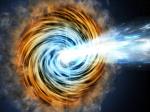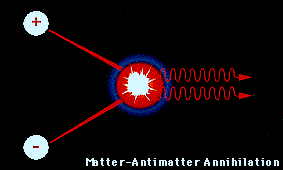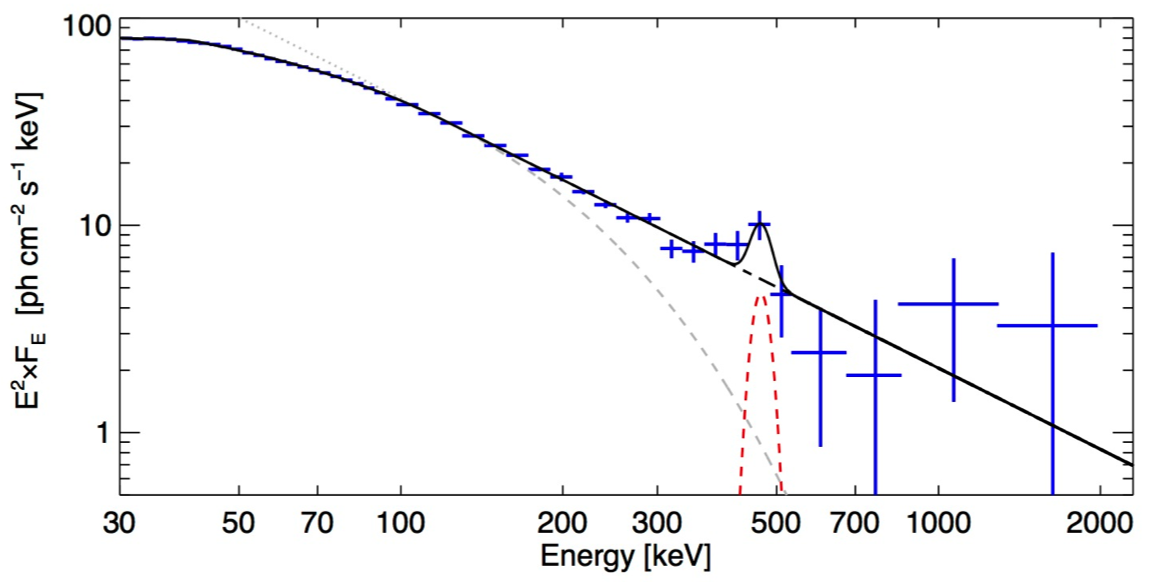Analysis of the high-energy emission from the microquasar V404 Cygni has lead to the discovery of gusts of electron and positron (the electron anti-particle) plasma. This amazing discovery was possible thanks to the exquisite sensitivity of the INTEGRAL/SPI spectrometer during a strong outburst of the source in June 2015. These findings show that microquasars can be very efficient to provide significant pairs electron-positron and thus can be considered somehow as “antimatter factories”. V404 Cygni shows during this outburst several types of flares, detected at all wavelengths, some of them reaching records of brightness in the gamma-ray range. This diversity is described in a complementary study, which shows that in this binary system, high velocity matter ejections occur in form of jets. These observations highlight the key role of microquasars in the origin of the diffuse emission of electron-positron annihilation line in the galactic bulge and the still poorly known galactic gamma-ray background diffuse emission. These studies are described in two papers, the first under the leadership of a team from the Max-Planck-Institut für extraterrestrische Physik (MPE) in Garching, Germany and published in the 2016 February 29th edition of Nature, and the second lead by researchers from the Astrophysics division/laboratory AIM of CEA-Irfu and published in the revue Astronomy and Astrophysics end of 2015. In both studies, scientists from MPE and SAp joined their effort with other colleagues to analyse data from the INTEGRAL satellite, currently the unique high energy observatory allowing such findings and discoveries.
Pair Plasma ejection during an extreme period of activity
V404 Cygni is an X-ray binary composed of a low mass star (companion star) and a black hole. It belongs to the class of microquasars, “accreting” binary systems (i.e. system where the matter from the companion star is accreted by the black hole), which sporadically eject plasma in relativistic jets. In June 2015, this source entered into an exceptional outburst, focusing the interest and observational efforts of the scientific community. Many observatories, both on ground or in space, were alerted of this exceptional event and started a multi-wavelength follow-up of the outburst. Amongst this effort, the ESA satellite INTEGRAL played a key role.
During the INTEGRAL observing campaign, the data acquired by the SPI spectrometer have allowed scientists to discovered intense bursts of photons at energy of 511 keV. This is signature of the annihilation of an electron with its anti-particle, the positron. The line intensity observed during the flaring activity implies a very large production of pairs, more than 10**42 per second during the flares.
|
Left: schematic representation of the annihilation of an electron and a positron leading the production of two photons of 511 keV. Right panel: Spectral energy distribution obtained with the SPI spectrometer during one of the main flare of V404 Cygni. A 511 keV emission line is visible on top of an X and gamma-ray continuum emission originating from different processes (interaction of thermal photons in an accretion disc with energetic electrons present in a surrounding plasma, the corona, and/or radiation from the energetic jet). |
|
A careful analysis of the line emission profile, possible thanks to the superb SPI spectrometer capabilities, shows that the line shows different patterns from one flare to another. Several hypothesises are suggested to explain this behaviour: the annihilation could occur in regions with different temperatures, could be associated with a specific morphology of the environment or might be witnessing magnetic field contribution. The extreme gravitational field near the black hole could also induce a gravitational redshift and play a role.
Fast and intense light variations
The activity of V404 Cygni during this strong outburst has allowed, thanks to the complementarity instruments, from optical to gamma-ray, on-board the INTEGRAL observatory to study in detail the behaviour of the flares. The ISGRI camera has, in particular, seen in the hard X-rays (photon energy between 20 and 300 keV) intense variations of fluxes on a rather short time-scale (the source flux could vary by a factor about 1000 on a typical time-scale of an hour).
|
This movie shows the V404 Cygni intensity variations detected by the ISGRI detector during its activity period in June 2015. The sequence starts on 2015, June 18th (MJD for Modified Julian Day 57191) and lasts 14 days. The flux variation during this period is showed in the curve in the lower panel, while the upper left image shows the ISGRI images during the same time interval (field of view 9x9 degrees). The position of V404 Cygni is indicated with a circle at the beginning of the sequence and two other microquasars are visible: Cyg X-1 et Cyg X-3. The upper right panel shows the source’s signal in the 20-40 keV energy range. Each image of the sequence spans about 2000s, while the time step of the red curve in the upper right panel is 32 s. The interruptions of signal in the sequence are due to satellite constraints. Credits: CEA/Service d’Astrophysique (V. Chambouleyron) |
During the largest flares, the source has reached records in terms of intensity, with the brightest episode being 50 times more luminous than the Crab Nebula, an already bright standard candle in this spectral domain. The different flares have various physical origin, in particular some manifest at optical wavelengths detected with the optical monitor on-board INTEGRAL. These multi-wavelengths flares are interpreted as being due to the accretion disc that surrounds the black hole and its associated powerful jets of particles, a hypothesis supported by simultaneous radio observations.
The diffuse galactic gamma-ray emission and microquasars
Apart from a better understanding of the processes at work in X-ray binaries and microquasars, the study of the annihilation line brings new clues on the long-standing question regarding the origin of the galactic bulge 511 keV emission. This study, indeed, shows that V404 Cygni produces a large quantity of pair-plasma during the large flares over about ten days of activity. The galactic bulge emission observed at the energy of 511 keV implies that, at any time, ten sources like V404 Cygni suffer a similar state of activity. Considering a duty-cycle (ratio of outburst period versus quiescent phase) of 1/1000 leads to a number of about 1000-10000 systems similar to V404 Cygni located in the galactic bulge to explain the observed emission. This scenario is, at least, compatible with the prediction of stellar population synthesis that predict that about 100 millions black holes lurk in our Galaxy.
These works confirm the key role of microquasars in feeding with pair plasma the central regions of our Galaxy and their impact on the MeV excess observed in the diffuse galactic gamma-ray emission.
Note : V404 Cygni is a binary system composed of a 0.7 solar mass star orbiting around a 10 solar mass black hole with an orbital period of 6.4 days. It is located at 2.4 kpc (about 8000 light-years) from Earth in the Cygnus constellation. In 1989, the Japanese X-ray satellite Ginga discovered a source, GS 2023+338, which was later associated with nova V404 Cygni. This system had undergone two strong outbursts before 1989, in 1934 and 1956, both detected in optical.
Contacts : Jérôme Rodriguez (CEA)
Publications :
" Pair plasma in the microquasar V404 Cygni "
Thomas Siegert, Roland Diehl, Jochen Greiner, Martin G. H. Krause, Andrei M. Beloborodov, Marion Cadolle Bel, Fabrizia Guglielmetti, Jerome Rodriguez, Andrew W. Strong, and Xiaoling Zhang
published in Nature, 2016 February, 29th
See electronic version version
" Correlated optical, X-ray, and gamma-ray flaring activity seen with INTEGRAL during the 2015 outburst of V404 Cygni "
J. Rodriguez, M. Cadolle Bel, J. Alfonso-Garzón, T. Siegert, X.-L. Zhang, V. Grinberg, V. Savchenko, J. A. Tomsick, J. Chenevez, M. Clavel, S. Corbel, R. Diehl, A. Domingo, C. Gouiffès, J. Greiner, M. G. H. Krause, P. Laurent, A. Loh, S. Markoff, J. M. Mas-Hesse, J. C. A. Miller-Jones, D. M. Russell and J. Wilms
Published in Astronomy and Astrophysics, 2015, 581, L9
See electronic version
See - The CEA press release (in french)
- The MPE press release
See also : Les informations microquasars sur le site du SAp (in french)
Rédaction : C. Gouiffès
• Thèmes de recherche du Service d'astrophysique
• The Astrophysics Division (DAp)
• High Energy Cosmic Phenomena Research Laboratory
• INTEGRAL






